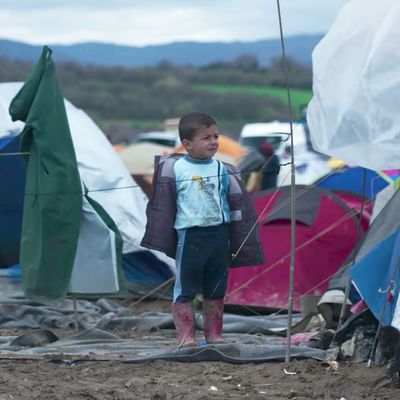
Do not make the mistake, as I did, of trying to do a double feature with Ai Weiwei’s Human Flow and any other film. For one thing, the documentary very nearly reaches the three-hour mark, and you’re going to want a good stretch after that. But more importantly, after the exhaustive tour of every refugee crisis currently going on in the world, and the harrowing conditions faced by people whose only mistake was living in a troubled country, it’s hard to find room to care about much of anything else.
Ai, an internationally renowned artist known for his confrontational political art and open criticism of the Chinese government, approaches his subject with a kind of trembling calm, letting our jaws drop of their own accord as he introduces each new wave of displaced people. The film opens with a single refugee boat in the waters of the Aegean Sea. It appears to be precariously small in the blue expanse, but as it comes ashore on the Greek island of Lesvos, we see that its holding hundreds of Syrian refugees, and learn from the passengers that there are more boats on the way. As Ai follows one group on their journey through Greece to the Macedonian border, what starts as a trickle becomes a stream, and the flow of the film’s title becomes blocked and constricted nearly every step of the way.
Though most Americans are probably the most familiar with the circumstances of the crisis of Syrian refugees seeking asylum in Europe and abroad, Ai’s film surveys a plethora of other displaced people and human-rights crises, from the Kenyan refugee crisis to the plight of the Rohingya people in Bangladesh to Afghani refugees finally beginning to return to their homes. At one point, he and his crew travel to the U.S.-Mexico border, where a patrolman exchanges tense words with them. The almost incomprehensible scale of this problem on a phenomenological level seems to be what Ai is trying to get across; but after the halfway point it starts to feel as if he’s lost focus, that the subject is too big for one film to get its arms around. As if to acknowledge this, the film is punctuated with frequent bird’s-eye drone shots, where massive temporary encampments and human processions take on the appearance of blood cells pushing their way through clogged arteries.
Human Flow is at its best when it’s closer to eye level, though, and more intimately focused on the Syrian crisis. As the families make their way to the Macedonian border, which has closed to refugees sooner than scheduled, Ai’s camera follows them with a slightly elevated Steadicam, placing us in the procession but also allowing us to see the mass of people in every direction. From the muddy, miserable encampment at Idomeni, to the hyperclean shelter waiting for those travelers lucky enough to make it to Berlin’s Tempelhof hangar, the anxiety and uncertainty of endless itinerancy is conveyed deeply and viscerally. (It mostly skirts the graphic tragedies seen in photo galleries in papers of record, but there is a shot of a dead, maimed child outside Mosul so upsetting that it seems fair to warn potential viewers.) But there’s a disconnect and a lack of momentum, especially when considering the direness of the human factor here. Ai clearly wants to take a macro view of an impossible problem, to find some clarity in abstraction. But whenever he just talks to the refugees face to face, we learn more than any drone shot could tell us.




